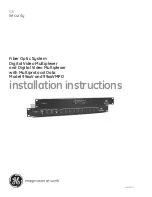
NetXpress LX & CM-30R Installation & Operation Manual
2
–
Functional Design
Version 1.1
2-20
GatesAir, Inc.
Intraplex Products
server using the same process, only in reverse order. Restored configuration takes effect when the
CM-30R module is rebooted.
2.13 Fault Detection and Reporting
With the use of SNMP traps, the CM-30R system detects and reports on a number of alarm conditions.
2.13.1 Alarm Hierarchy
The CM-30R system has major and minor alarms. A major alarm is a fault that has a direct effect on
service, such as a component failure disrupting the delivery or reception of data. A minor alarm is a
fault that has no effect on service, including all other errors detected which do not affect CM-30R
operation.
The CM-30R system is also equipped with an alarm cutoff (ACO) switch. The ACO is a switch that can
be enabled to reduce the major alarm output signal to a minor alarm output as an over-ride until the
situation can be corrected.
The indicator lights on the front panel of the NetXpress LX or original Intraplex power supply modules
and on the NetXpress LX Home page give system alarm states (Section 4.3.1
–
Start at NetXpress LX
Home Page
):
●
Red light = Major shelf alarm (Alarm)
●
Yellow light = Minor shelf alarm (Alert)
●
Green light = No alarm condition exists (Normal)
2.13.2 Alarm History
You can review current alarms and alarm history from the
NetXpress LX Home
page. Go to
Faults
|
Alarm Table
to display the
Current Alarms
screen or
Faults
|
Alarm History
to display the
Alarm
History
screen. Both screens contain this data:
●
A list of alarms
●
Dates and times the alarms occurred
●
Severity of the alarms
●
A description of each alarm occurrence
For troubleshooting and future reference, you can also off-load he NetXpress LX system alarm history
to a text file.
2.13.3 SNMP Traps Use for Fault Reporting
SNMP traps detect and report system faults. System events that generate SNMP traps include stateful
events (considered ON/OFF alarm events) and informational events (non-alarm, one-time-only
events).
Equipment-related system events indicate a hardware failure on the CM-30R module or in the shelf.
Processing-related system events indicate a failure was detected in software processing. Facility-
related system events indicate a failure occurred with one of the operation interfaces.
The available list of SNMP traps changes with each software version. The Notification section in the
MIB file supplied with your version of CM-30R application software gives a list of available SNMP traps.
















































